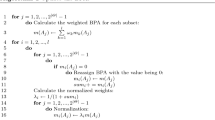Abstract
In Dempster-Shafer evidence theory, the pignistic probability function is used to transform the basic probability assignment (BPA) into pignistic probabilities. Since the transformation is from the power set of the frame of discernment to the set itself, it may cause some information loss. The distance between betting commitments is constructed on the basis of the pignistic probability function and is used to measure the dissimilarity between two BPAs. However, it is a pseudo-metric and it may bring unreasonable results in some cases. To solve such problem, we propose a power-set-distribution (PSD) pignistic probability function based on the new explanation of the non-singleton focal elements in the BPA. The new function is directly operated on the power set, so it takes more information contained in the BPA than the pignistic probability function does. Based on the new function, the distance between PSD betting commitments which can better measure the dissimilarity between two BPAs is also proposed, and the proof that it is a metric is provided. In order to demonstrate the performance of the new distance, numerical examples are given to compare it with three existing dissimilarity measures. Moreover, its applications in combining the conflicting BPAs are also presented through two examples.


Similar content being viewed by others
Explore related subjects
Discover the latest articles, news and stories from top researchers in related subjects.References
Dempster AP (1967) Upper and lower probabilities induced by a multivalued mapping. Ann Math Stat 38 (1):325–339
Shafer G (1976) A mathematical theory of evidence. Princeton University Press, Princeton
Zadeh L (1984) Review of a mathematical theory of evidence. AI Mag 5(2):235–247
Zadeh L (1986) A simple view of the Dempster–Shafer theory of evidence and its implication for the rule of combination. AI Mag 7(1):85–90
Liu W (2006) Analyzing the degree of conflict among belief functions. Artif Intell 170(9):909–924
Jousselme AL, Maupin P (2012) Distances in evidence theory: Comprehensive survey and generalizations. Int J Approx Reason 53(1):118–145
Jousselme AL, Maupin P On some properties of distances in evidence theory Workshop on the theory of belief functions, Brest, France, p 2010
Perry WL, Stephanou HE (1991) Belief function divergence as a classifier Proceedings of the 1991 IEEE international symposium on intelligent control, Arlington, VA, USA
Blackman S, Popoli R (1999) Design and analysis of modern tracking systems. Artech House, Norwood
Tessem B (1993) Approximations for efficient computation in the theory of evidence. Artif Intell 61(1):315–329
Jousselme AL, Grenier D, Bossé É. (2001) A new distance between two bodies of evidence. Information Fusion 2(1):91–101
Cuzzolin F Consistent approximations of belief functions 6Th international symposium on imprecise probability: Theories and applications, Durham, UK, p 2009
Zouhal L, Denoeux T (1998) An evidence-theoretic k–NN rule with parameter optimization. IEEE Trans Syst Man Cybern Part C Appl Rev 28(1):263–271
Ristic B, Smets P (2006) The TBM global distance measure for the association of uncertain combat ID declarations. Information Fusion 7:276–284
Wen C, Wang Y, Xu X (2008) Fuzzy information fusion algorithm of fault diagnosis based on similarity measure of evidence Advances in neural networks, lecture notes in computer science, vol 5264. Springer, Berlin, pp 506–515
Florea MC, Bossé E. Crisis management using Dempster Shafer theory: using dissimilarity measures to characterize sources’ reliability C3i in crisis, emergency and consequence management, RTO–MP–IST–086, Bucharest, Romania, p 2009
Hellinger E (1909) Neaue begründung der theorie der quadratischen formen von unendlichen vielen veränderlichen. Journal fü,r die Reine und Aangewandte Mathematik 136:210–271
Denoeux T (2001) Inner and outer approximation of belief structures using a hierarchical clustering approach. Int J Uncertainty Fuzziness Knowledge Based Syst 9(3):437–460
Denoeux T (1997) A neural network classifier based on Dempster–Shafer theory. IEEE Trans Syst Man Cybern Syst Hum 30(1):131–150
Han DQ, Deng Y, Han CZ, et al. (2012) Some notes on betting commitment distance in evidence theory. Science China–Information Sciences 55(2):558–565
Smets Ph, Kennes R (1994) The transferable belief model. Artif Intell 66(1):191–234
Smets Ph (1990) The combination of evidence in the transferable belief model. IEEE Trans Pattern Anal Mach Intell 12(4):447–458
Chen S, Deng Y, Wu J (2013) Fuzzy sensor fusion based on evidence theory and its application. Appl Artif Intell 27(2):235–248
Du HL, Lv F, Du N (2012) A method of multi–classifier combination based on Dempster–Shafer evidence theory and the application in the fault diagnosis. Adv Mater Res 490–495:1402– 1406
Huang SY, Su XY, Hu Y, et al. (2014) A new decision–making method by incomplete preferences based on evidence distance. Knowl-Based Syst 56(2):264–272
Cuzzolin F (2004) Geometry of Dempster’s rule of combination. IEEE Trans Syst Man Cybern B Cybern 34 (1):961–977
Cuzzolin F (2008) A geometric approach to the theory of evidence. IEEE Trans Syst Man Cybern Part C Appl Rev 38(3):522– 534
Bouchard M, Jousselme AL, Dore PE (2013) A proof for the positive definiteness of the Jaccard index matrix. Int J Approx Reason 54(4):615–626
Liu ZG, Dezert J, Pan Q, Mercier G (2011) Combination of sources of evidence with different discounting factors based on a new dissimilarity measure. Decis Support Syst 52(1):133–141
Deng Y, Shi WK, Zhu ZF, Liu Q (2004) Combining belief functions based on distance of evidence. Decis Support Syst 38(2):489–493
Acknowledgments
This work is supported by the National Natural Science Foundation of China under grants 61273275, 60975026 and 61573375. The authors also want to thank the anonymous reviewers for their detailed comments that have helped greatly in improving the quality of this paper.
Author information
Authors and Affiliations
Corresponding author
Rights and permissions
About this article
Cite this article
Zhu, J., Wang, X. & Song, Y. A new distance between BPAs based on the power-set-distribution pignistic probability function. Appl Intell 48, 1506–1518 (2018). https://doi.org/10.1007/s10489-017-1018-9
Published:
Issue Date:
DOI: https://doi.org/10.1007/s10489-017-1018-9




